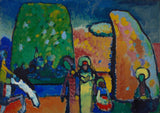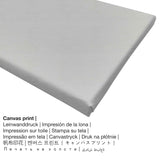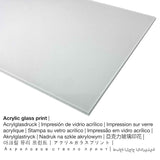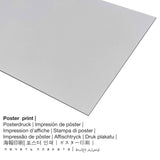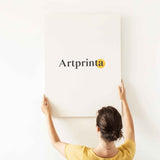Wassily Kandinsky, 1909 - Utafiti wa uboreshaji Na. 2 (maandamano ya mazishi) - chapa nzuri ya sanaa
Kodi ni pamoja. Usafirishaji umehesabiwa katika Checkout.
ufafanuzi wa bidhaa
Katika 1909 Wasily Kandinsky made the 20th century piece of art. The painting had the following size: 49,8 cm x 69,8 cm , 50 cm x 69,5 cm and was painted with the mbinu oil on cardboard. The original artwork has the following text as inscrption: "1909 Wassily Kandinsky began many of his more important new plants in three categories divide into "impressions," "improvisations" and "compositions". Under "impressions" he understood "impressions of external nature," the "compositions" a deliberate, rational as well as emotional painting, which according to their own laws organized itself (see. Table 29, 30). The group of "improvisation", however, Kandinsky described as "mostly unconscious, mostly suddenly resulting expressions of processes internal character as impressions of the 'inner nature'". The "Study of Improvisation 2 (Funeral March)", whose final version is in the Moderna Museet, Stockholm, is one of the first created and numerous other improvisations that Kandinsky to 1913 numbered in a continuous series. Before an unreal, unreal reminiscent of landscape elements scenery three Russian-looking female characters are at the leading edge gathered in the middle, another sits slightly removed their right, while a rider from coming in left on a white horse in the picture. A touch of symbolism is above the enigmatic scene. As later in a series of "improvisation" characterizes the motive treasure of the fairytale, Russian images even here, despite the formal changes the whole character of this "impression of inner nature." The sub-title designation "Funeral March" indicates less an act but rather the image the mood. In its muted, portentous character, the "Image with Kahn" from 1909 or earlier "Three Women" are roughly comparable, giving in compositional terms as in terms of individual elements clues for the interpretation of "Improvisation 2". Thereafter can the deep blue strip forward as separating the pieces on a ramp identify than water, the two large colored blocks behind them are mountains or cliffs, the round annealed form between them a cloud. But these block-like forms, in particular the right to the bright orange and light blue 'back', seem to turn into organic forms, not least due to the sophisticated color that meets their domestic fields with restless life. In a similarly low-slung stance, the schematic female figures and the on-coming riders from the left remain. is with him appears a central figure of the imagination Kandinsky, often encountered, especially in the group of "improvisation" and not least the symbolic figure of the "Blue Rider" are. All figures are cut off by the edge of the image, which obscures their meaning. Apparently Kandinsky studied in the "improvisations" for anti substantive expressions. The Verunklärungen of form and content are steps on the way to a new, autonomous reality of the painting.". It belongs to the digital art collection of Städtische Galerie im Lenbachhaus und Kunstbau München. This modern art masterpiece, which is in the Uwanja wa umma is included with courtesy of Wassily Kandinsky, Studie zur Improvisation Nr. 2 (Trauermarsch), 1909, Oil On Cardboard, 49,8 cm x 69,8 cm , 50 cm x 69,5 cm, Städtische Galerie im Lenbachhaus und Kunstbau München, https://sammlungonline.lenbachhaus.de/objekt/studie-zur-improvisation-nr-2-trauermarsch-30019275.html. : Städtische Galerie im Lenbachhaus und Kunstbau München. Kwa kuongezea hayo, upatanishi wa uzazi wa kidijitali uko katika mandhari format na uwiano wa picha wa 1.4: 1, ambayo ina maana kwamba urefu ni 40% zaidi ya upana.
Nyenzo za bidhaa unaweza kuchagua
Katika uteuzi wa kushuka kwa bidhaa unaweza kuchagua saizi na nyenzo unayopenda. Chaguzi zifuatazo zinapatikana kwa ubinafsishaji:
- Bango lililochapishwa (nyenzo za turubai): The Artprinta poster is a printed cotton canvas with a granular structure on the surface. The poster print is suited for framing the art print in a customized frame. Please keep in mind, that depending on the size of the poster print we add a white margin of something between 2-6cm round about the work of art in order to facilitate the framing.
- Uchapishaji wa glasi ya akriliki (iliyo na mipako halisi ya glasi): The print on acrylic glass, which is sometimes referenced as a fine art print on plexiglass, will convert your favorite original work of art into brilliant décor. Your artwork is custom-made with modern UV direct print machines.
- Turubai: A printed canvas, which should not be confused with a canvas painting, is an image printed on a canvas fabric. It makes the unique effect of three dimensionality. Canvas prints are relatively low in weight, which means that it is easy and straightforward to hang the Canvas print without additional wall-mounts. Therefore, canvas prints are suitable for all kinds of walls.
- Mchapishaji wa dibond ya Alumini: Aluminium Dibond prints are metal prints with an impressive depth. The Direct Print on Aluminum Dibond is the perfect introduction to art reproductions on alu. The bright and white parts of the work of art shimmer with a silk gloss, however without any glare. Colors are bright and vivid in the highest definition, details of the print are crisp and clear, and the print has a a matte look that you can literally feel.
Muktadha wa metadata ya msanii
| Jina la msanii: | Wasily Kandinsky |
| Raia: | russian |
| Kazi: | mchoraji |
| Nchi ya asili: | Russia |
| Uainishaji wa msanii: | msanii wa kisasa |
| Alikufa akiwa na umri wa miaka: | miaka 78 |
| Mzaliwa: | 1866 |
| Mwaka ulikufa: | 1944 |
| Alikufa katika (mahali): | Neuilly-sur-Seine, Ufaransa |
Data ya usuli kuhusu kazi asilia ya sanaa
| Jina la sanaa: | "Study for improvisation no. 2 (funeral march)" |
| Uainishaji: | uchoraji |
| Muda wa mwavuli: | sanaa ya kisasa |
| Uainishaji wa muda: | 20th karne |
| Imeundwa katika: | 1909 |
| Takriban umri wa kazi ya sanaa: | zaidi ya miaka 110 |
| Mchoro wa kati wa asili: | mafuta kwenye kadibodi |
| Vipimo vya mchoro asilia: | 49,8 cm x 69,8 cm , 50 cm x 69,5 cm |
| Uandishi asili wa kazi ya sanaa: | 1909 Wassily Kandinsky began many of his more important new plants in three categories divide into "impressions," "improvisations" and "compositions". Under "impressions" he understood "impressions of external nature," the "compositions" a deliberate, rational as well as emotional painting, which according to their own laws organized itself (see. Table 29, 30). The group of "improvisation", however, Kandinsky described as "mostly unconscious, mostly suddenly resulting expressions of processes internal character as impressions of the 'inner nature'". The "Study of Improvisation 2 (Funeral March)", whose final version is in the Moderna Museet, Stockholm, is one of the first created and numerous other improvisations that Kandinsky to 1913 numbered in a continuous series. Before an unreal, unreal reminiscent of landscape elements scenery three Russian-looking female characters are at the leading edge gathered in the middle, another sits slightly removed their right, while a rider from coming in left on a white horse in the picture. A touch of symbolism is above the enigmatic scene. As later in a series of "improvisation" characterizes the motive treasure of the fairytale, Russian images even here, despite the formal changes the whole character of this "impression of inner nature." The sub-title designation "Funeral March" indicates less an act but rather the image the mood. In its muted, portentous character, the "Image with Kahn" from 1909 or earlier "Three Women" are roughly comparable, giving in compositional terms as in terms of individual elements clues for the interpretation of "Improvisation 2". Thereafter can the deep blue strip forward as separating the pieces on a ramp identify than water, the two large colored blocks behind them are mountains or cliffs, the round annealed form between them a cloud. But these block-like forms, in particular the right to the bright orange and light blue 'back', seem to turn into organic forms, not least due to the sophisticated color that meets their domestic fields with restless life. In a similarly low-slung stance, the schematic female figures and the on-coming riders from the left remain. is with him appears a central figure of the imagination Kandinsky, often encountered, especially in the group of "improvisation" and not least the symbolic figure of the "Blue Rider" are. All figures are cut off by the edge of the image, which obscures their meaning. Apparently Kandinsky studied in the "improvisations" for anti substantive expressions. The Verunklärungen of form and content are steps on the way to a new, autonomous reality of the painting. |
| Makumbusho / mkusanyiko: | Städtische Galerie im Lenbachhaus und Kunstbau München |
| Mahali pa makumbusho: | Munich, Bavaria, Ujerumani |
| Inapatikana chini ya: | www.lenbachhaus.de |
| leseni: | Uwanja wa umma |
| Kwa hisani ya: | Wassily Kandinsky, Studie zur Improvisation Nr. 2 (Trauermarsch), 1909, Oil On Cardboard, 49,8 cm x 69,8 cm , 50 cm x 69,5 cm, Städtische Galerie im Lenbachhaus und Kunstbau München, https://sammlungonline.lenbachhaus.de/objekt/studie-zur-improvisation-nr-2-trauermarsch-30019275.html |
| Mstari wa mkopo wa kazi ya sanaa: | Städtische Galerie im Lenbachhaus und Kunstbau München |
Maelezo ya usuli wa makala
| Chapisha bidhaa: | nakala ya sanaa |
| Mbinu ya uzazi: | uzazi wa kidijitali |
| Mchakato wa uzalishaji: | Uchapishaji wa moja kwa moja wa UV |
| Asili ya bidhaa: | zinazozalishwa nchini Ujerumani |
| Aina ya hisa: | juu ya mahitaji |
| Bidhaa matumizi: | picha ya ukuta, mapambo ya nyumbani |
| Mpangilio wa picha: | mpangilio wa mazingira |
| Uwiano wa picha: | 1.4: 1 - urefu: upana |
| Kidokezo: | urefu ni 40% zaidi ya upana |
| Nyenzo unaweza kuchagua kutoka: | chapa ya glasi ya akriliki (yenye mipako halisi ya glasi), chapa ya bango (karatasi ya turubai), chapa ya chuma (dibond ya alumini), chapa ya turubai |
| Turubai kwenye fremu ya machela (kuchapishwa kwa turubai): | 70x50cm - 28x20" |
| Chaguzi za kuchapisha glasi ya Acrylic (na mipako halisi ya glasi): | 70x50cm - 28x20" |
| Vibadala vya kuchapisha bango (karatasi ya turubai): | 70x50cm - 28x20" |
| Chaguzi za ukubwa wa Dibond (nyenzo za alumini): | 70x50cm - 28x20" |
| Muundo wa nakala ya sanaa: | si ni pamoja na |
disclaimer: We try in order to depict our products as closely as possible and to display them visually. Although, the pigments of the printed materials, as well as the printing can differ slightly from the representation on the monitor. Depending on the screen settings and the condition of the surface, not all color pigments will be printed as realisitcally as the digital version depicted here. Because our are processed and printed manually, there may as well be minor discrepancies in the motif's size and exact position.
© Hakimiliki ya - Artprinta (www.artprinta.com)

